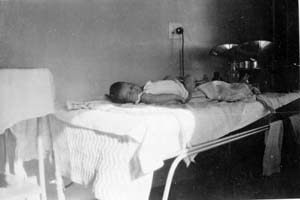The Early History of the Hospital
by Bill Michael, Chairman of the Hospital Board
June 11, 1980
Interviewer: Robert M. Copeland

Bill Michael was involved as a civic leader with the hospital for almost thirty years, and had served nineteen years as Chairman of the Hospital Board, when he shared "a few personal glimpses of the hospital history that are probably not included in the archives or the public records."
Michael's knowledge of the hospital history preceded his own long association with this institution; he had known many long-time members of the medical staff who shared knowledge from their experiences and that of their predecessors.
The history of the hospital dates back to the turn of the century, and there is evidence to indicate that the Larimer County Hospital was established on the ground of the County Poor Folks and Old Folks Home. "I remember some of the earlier doctors telling me that the eastern portion of the present hospital grounds was the early Fair Ground. From other data it would appear that the first patients were admitted to the Larimer County Hospital in September of 1903. This record seems to indicate that Larimer County Hospital was established to provide hospital care for the residents of the County Poor Farm and the County Old Folks Farm. There is some evidence that the facilities were made available to an occasional private patient who was able to pay for care."
"It must be remembered that during those years, hospitals played an entirely different role than they do now . . .practically all patients were cared for either in the home or in the attending physician's office and were admitted to the hospital only in critical cases."
According to Michael, the early hospital and related facilities operated a forty-acre farm, that provided large quantities of fresh fruits and vegetables. These were consumed fresh during the growing season by the patients and residents of the Poor Farm and Old Folks home; they also canned and stored the produce for their use during the winter months. This custom continued until about 1940. In the l980s there were still hospital employees who recalled taking their families to help with the harvest and the canning of the produce.
There was also a dairy herd, hogs and chickens and a flock of sheep, which hospital employees would butcher and prepare for the patients. "Of course, this was a real treat for the patients, but it was even more than that, because it helped a struggling hospital to survive."
This so-called Poor Farm and Larimer County Hospital continued until the first phase of the present hospital building was built in 1925. "When one speaks of a County Hospital and a County Poor Farm, it conjures up images of a depressing, impoverished catacombs; but this was not that kind of place at all. This was a beautiful place. Many of the current residents of Fort Collins remember that it resembled a large country home with large veranda and tall white pillars. It was nestled in a grove of cottonwood trees. The Doctor's Lounge was like a large living room with a huge fireplace. At Christmas time they'd have a Christmas tree, and the doctors and employees would exchange gifts just like in a large family."
The doctors would meet in the lounge in the morning and discuss their cases, with doctors advising and helping each other. Although the early doctors were not formally associated with each other, Michael considers that the hospital had the "original group practice." " It was wonderful the way they cooperated and functioned together. The hospital staff functioned the same way. If a nurse needed assistance, she'd run out in the hallway and call for help, and help was always responsive." Michael recalls this as one of the most beautiful times in the growth of the hospital, "because it developed a home-like heritage from which grew the love and compassion and the caring and sharing that you see exemplified in the hospital today."
From the time the original structure was completed and up to and through World War II, the operation remained pretty much the same because, for at least a ten-year period, everything was limited by the Depression; few patients were able to pay for their care. This period also saw the beginning of the Colorado Old Age Pension, so charitable homes were no longer necessary. During the late thirties the livestock was eliminated and the facility became "just" a hospital.
The post-World War II years brought about drastic changes in hospitals. The hardships of the Depression and the turmoil of the war years were past and there were advances in medical care and many "wonder drugs." The population grew rapidly because of returning military personnel and increases in the college's enrollment. The kitchen was remodeled and two wings were added to the hospital. A wing was named after Ernest Fisher who had served the county for many years as County Commissioner and "was one of the best loved men that ever graced this valley."
Michael's reflections continue in his complete oral history that is available for check-out at the Library.


Preserving the history of Fort Collins, Colorado & the Cache la Poudre region